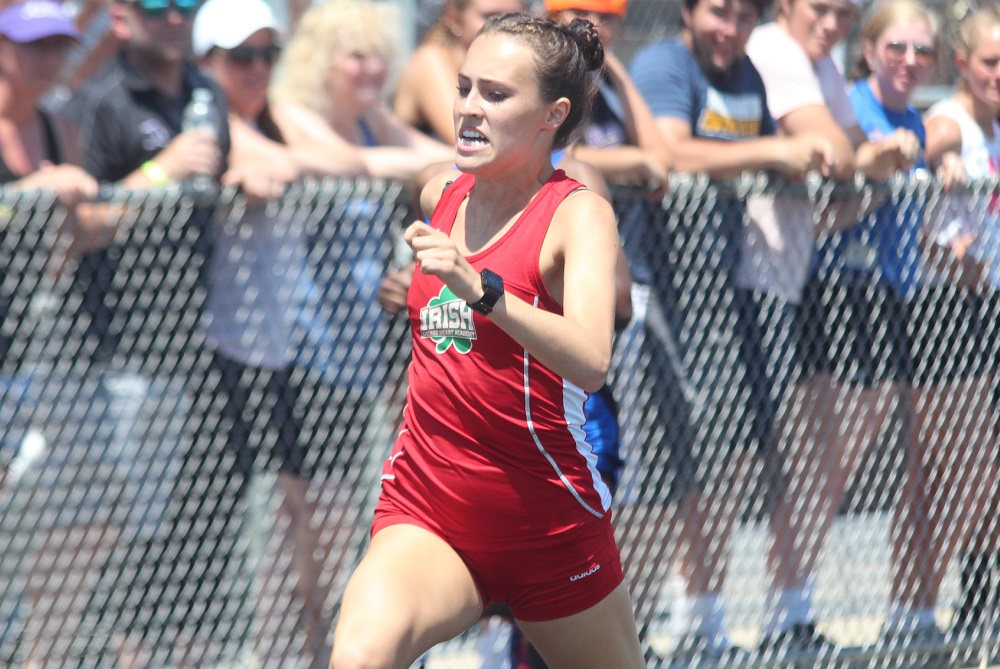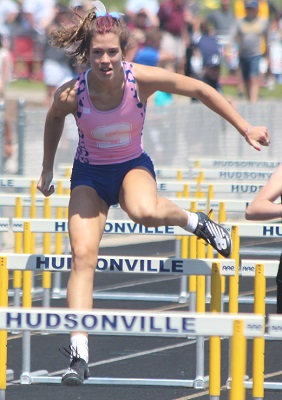
Sacred Heart Finishes Championship Climb for 1st Time
By
Will Kennedy
Special for Second Half
June 5, 2021
HUDSONVILLE —The Mount Pleasant Sacred Heart girls track & field team was looking forward to a fun hour-and-a-half trek back home after the Irish claimed their first MHSAA Finals championship in their sport Saturday in Hudsonville.
Sacred Heart finished the day with 51 points, beating out Hillsdale Academy by six. Coach Adam Grifka was holding back tears after he realized what his team had just accomplished. He said it was an uphill climb all season, but they got it done at the right time.
 “At the beginning of the season, we had a really low turnout. I thought there was no way,” Grifka said. “We just had everyone do so good today. The biggest thing I told them was to show up and compete no matter what.”
“At the beginning of the season, we had a really low turnout. I thought there was no way,” Grifka said. “We just had everyone do so good today. The biggest thing I told them was to show up and compete no matter what.”
They did just that, earning an individual when junior Nicole Olivieri came out on top in the 400 meters with a time of 57.47, a new personal record. And then the Irish just chipped away, claiming points in eight events total.
Olivieri was the catalyst for her team in the sprints. Not only did she earn the individual title, but she ran the anchor leg in the 800 and 1,600 relays. Sacred Heart won both events with times of 1:49.04 and 4:10.74, respectively, both setting school records.
“I started out the season with a 64-second 400, so dropping it to a 57 is just crazy,” Olivieri said. “I never thought I would be running these times; it’s insane to me.”
She wasn’t the only athlete to put together an impressive day. Lilly Bilbey from Alcona earned two individual titles, in the 100 and 200 with times of 12.51 and 26.58, respectively. Tess VanDyk from Kalamazoo Christian also earned two individual titles, sweeping the throwing events.
Saugatuck senior Jillian Johnson had a solid day as well, capturing her first individual title. She finished atop the podium in the long jump and shattered her own school record, breaking the 17-foot barrier for the first time with a leap of 17-00.75, just a quarter of an inch more than the second-place finisher.
 “It was crazy,” Johnson said. “When it was over 17 feet, it was just insane. ... Right when (the eventual runner-up) hit the board on her final attempt, she stuttered a little bit, so I knew I was going to take it at that point.”
“It was crazy,” Johnson said. “When it was over 17 feet, it was just insane. ... Right when (the eventual runner-up) hit the board on her final attempt, she stuttered a little bit, so I knew I was going to take it at that point.”
The Trailblazers also saw an impressive day from junior Aerin Baker. Though she didn’t come away with any event victories, she helped keep her team in contention all day scoring in three events, including a third-place finish in the long jump behind Johnson.
But when all was said and done, the history went to Mount Pleasant Sacred Heart. Olivieri said that even though it didn’t seem realistic at some points this season, she couldn’t be more proud of the way her team competed for every single second to come away as the best track team in its division.
“It’s pretty cool to be the first,” Olivieri said. “Everyone had to do their best today and give it all that they can, and they did. Everybody worked so hard. … It’s such a good feeling.”
PHOTOS: (Top) Mount Pleasant Sacred Heart’s Nicole Olivieri races toward one of her scoring finishes Saturday. (Middle) Saugatuck’s Aerin Baker leaps one of the hurdles during the 100 race. (Below) Sacred Heart celebrates its first track & field championship. (Photos by Will Kennedy.)

Track Gaining Speed Toward Future with Electronic Starting Devices
By
Steve Vedder
Special for MHSAA.com
May 23, 2023
Aubrey Greenfield thinks it might be the perfect time to reevaluate 130 years of tradition.
For a number of reasons, from technical to personal, the Oxford senior sprinter believes it makes sense for the crack of a starting pistol to be eliminated from high school track meets.
Because track meets would benefit in various ways from lowering costs to easier setup at meets to the human factor of competitors not having to flinch at the crack of a pistol shot, Greenfield believes the sport has a chance to embrace new technology – electronic starting devices (ESD).
In essence, an ESD replaces the starting pistol with a light flash, tone sound or both to begin a race.
"High school sports should put the athlete first," Greenfield said. "We should promote sports, and eliminating starting pistols promotes health in terms of PTSD or trauma for athletes and spectators and that would be good. I would like to think people would say that's a good idea."
In fact, Greenfield would go as far as to say if there was not an implementation of electronic starting devices, many of her teammates would have considered giving up the sport.
"If it's something that helps us compete safely, we're all for it," she said.
Greenfield's opinion apparently is spreading. Michigan High School Athletic Association senior assistant director Cody Inglis said the use of ESD makes it both affordable for meet starters and sensible for athletes and fans to rethink the use of starting pistols. While the MHSAA is not mandating electronic starting devices, it does promote the use of what Inglis calls "emerging technology." He notes that ESD are becoming the norm for organizations such as USA Track & Field, the NCAA and an increasing number of high schools.
 "I think we have to embrace new technology, and we think this will be something that takes hold," Inglis said.
"I think we have to embrace new technology, and we think this will be something that takes hold," Inglis said.
A key part of embracing ESD is the human element. The tragic Oxford High School shooting Nov. 30, 2021, that took the lives of four students while injuring seven others should not be relived even for a fleeting instance at a high school sporting event. Oxford athletic director Tony DeMare said the school began using ESD at every meet, including the MHSAA Lower Peninsula Division 1 Finals last June. He said that decision was embraced by virtually all schools Oxford encountered.
"We were very convinced that the alternative (of ESD) would promote a healthy attitude," DeMare said. "We were overwhelmed with the positive response. If a school was on the fence about it or might not be for it, I think we've started to see the tide turn in favor of people willing to listen and learn about electronic starting devices."
Inglis said the MHSAA is acutely aware of what the crack of a starting pistol can mean to athletes and fans.
"It's unimaginable what Oxford went through, and this is a small way we can help," he said. "We look at a (starting pistol) and think, ‘Could we do something else?’ It's a way of helping to solve a problem."
Over the last several years, the MHSAA has embraced finding an alternative to starting pistols. Inglis noted the discussion started with the cost and diminishing availability of 32-caliber ammunition that meet starters use. A box of ammunition, if it can be found, is around $75 a box.
In addition to cost, there is potential damage from excessive exposure to 150-plus decibels of sound generated by the traditional 32-caliber blanks. Medical studies show damage to ears caused by decibel levels above 120 dB.
The tragedy at Oxford accelerated the conversation.
Inglis said the cost of ESD can be likened to a school sinking money into artificial surfaces at football fields. Yes, there is a great cost at first, but over time money is ultimately saved. An ESD system itself ranges between $200 and $500. Speakers also may need to be purchased, but with ESD starting events like the 800 and 1,600-meter relays positioned near the outside lanes 8, 7, 6 and 5 would result in improved hearing by athletes at the start of a race.
There is one challenge with ESD that track administrators are working to overcome – lighting conditions that lessen the ability to see the ESD’s LED light or strobe when the button is pressed by a starter to begin a race. But that vision difficulty resulting from clear blue skies and backgrounds of setting suns can be substantially improved by incorporating a black background with an ESD – something as simple as a starter holding up black cardboard behind the lighting mechanism at the start of an event.
Inglis said when all factors are considered, the use of ESD makes sense.
 "With the climate we live in nowadays, no lookalike guns is good," he said. "We're not mandating this. But people are saying this is affordable."
"With the climate we live in nowadays, no lookalike guns is good," he said. "We're not mandating this. But people are saying this is affordable."
While switching to ESD would break 130 years of tradition, the timing could be a step forward, said Jeff Hollobaugh, co-author of the book "The Fleet Feet of Spring: Michigan's High School State Championships in Track & Field." He said while no definitive answer is possible, it's likely starting pistols were used at the inaugural state meet at the Jackson Fairgounds in 1895. The meet, which included events like tossing a 16-pound shot put, bike races and a 100-meter sprint, was sponsored by the Michigan Interscholastic Athletic Association (a predecessor to the MHSAA) and comprised mostly of the state's larger schools.
Hollobaugh's sentiments echo what many involved in today's high school track & field believe in terms of making a transition from starting pistols to electronic starting devices.
"It's a change, not necessarily good or bad, just different," he said. "It's not a drastic change, but it will take some getting used to. But it is the future. In the end, we'll all be fine."
DeMare believes the future of high school track will definitely include ESD.
"Our desire is that the practicality and sensibility of this will overcome the alternative," he said. "I think we'll see the automation and electronics taking hold of certain elements in track, and people will embrace it."
PHOTOS (Top) Runners watch official Bertha Smiley as they prepare to begin a race during last season's Lower Peninsula Division 1 Finals at Rockford. (Middle) An electronic starting device provided by VS Athletics was used to start those races. (Below) Smiley sets to begin an event. (Photos provided by David Kuderka/VS Athletics.)

